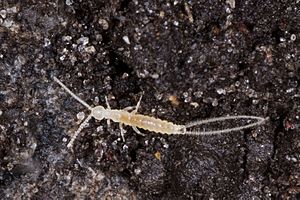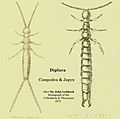Diplurans facts for kids
Quick facts for kids DipluransTemporal range: Upper Carboniferous
to present |
|
|---|---|
 |
|
| Scientific classification | |
| Kingdom: | |
| Phylum: | |
| Subphylum: | |
| Class: | |
| Order: |
Diplura
|
Diplurans are a fascinating group of tiny creatures, often called "two-pronged bristletails." They are part of a larger family called hexapods, which also includes well-known animals like insects, springtails, and Protura.
Scientists have discovered around 800 different kinds of diplurans worldwide. For example, about 70 types live in North America, 12 in Great Britain, and two in Australia. These small animals play an important role in their habitats.
Contents
What Are Diplurans?
Diplurans belong to a biological order within the animal kingdom. They are unique because they are one of the four main groups of hexapods. Hexapods are creatures that have six legs, just like insects!
Where Do They Live?
Most diplurans prefer to live in dark, damp places. You can often find them in soil, under rocks, or in decaying wood. They are usually hidden away from sunlight. This helps them stay safe and find food.
What Do They Look Like?
Diplurans are quite small, usually less than 10 millimeters long. Their bodies are long and slender. They have a pair of long antennae on their heads, which they use to feel their way around.
A key feature of diplurans is their two tail-like structures at the end of their bodies. These are called cerci. The shape of these cerci can vary a lot between different types of diplurans. Some are long and flexible, while others are short and pincer-like.
What Do They Eat?
Diplurans are mostly scavengers. This means they eat dead or decaying plant and animal matter. Some types might also hunt tiny living creatures, like small insects or mites. They help keep the soil clean by breaking down organic material.
Life Cycle of a Dipluran
Diplurans go through a simple life cycle. They hatch from eggs and look very much like tiny versions of the adults. As they grow, they shed their outer skin, a process called molting. They continue to molt throughout their lives, even as adults.
Images for kids



